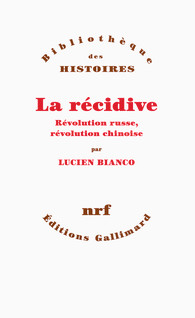Notice
Shanghai: China's Gateway to Modernity by Marie-Claire Bergère
- document 1 document 2 document 3
- niveau 1 niveau 2 niveau 3
Descriptif
Shanghai today is a thriving, bustling metropolis. But does its avid pursuit of the modern trappings of success truly indicate that it will once again become the shining example of China's commercial and cosmopolitan culture? While history continues to unfold, eminent China scholar Marie-Claire Bergère takes readers back to when Shanghai first opened to the world in 1842 to narrate the city's tumultuous and unique course to the present.
Shanghai: China's Gateway to Modernity is the first comprehensive history of Shanghai in any Western language. Divided into four parts, Bergère details Shanghai's beginnings as a treaty port in the mid-nineteenth century; its capitalist boom following the 1911 Revolution; the fifteen years of economic and social decline initiated by the Japanese invasion in 1937, and attempts at resistance; and the city's disgraced years under Communism. Weaving together a range of archival documents and existing histories to create a global picture of Shanghai's past and present, Bergère shows that Shanghai's success was not fated, as some contend, by an evolutionary pattern set into motion long before the arrival of westerners. Rather, her account identifies the relationship between the Chinese and foreigners in Shanghai—their interaction, cooperation, and rivalry—as the driving force behind the creation of an original culture, a specific modernity, founded upon western contributions but adapted to the national Chinese culture.
Eclipsed for three decades by socialism, the wheels of the Shanghai spirit began to turn in the 1990s, when the reform movement took off anew. The city is again being referred to as a model for China's current modernization drive. Although it makes no claims to what will happen next, Bergère's Shanghai stands as a compelling and definitive profile of a city whose urban history continues to be redefined, retold, and resold.
Bergère, Marie-Claire (2010). Shanghai: China's Gateway to Modernity. Trans. Janet Lloyd. Stanford, CA: Stanford University Press.
Original French: Histoire de Shanghai, Marie-Claire Bergère Paris, Fayard, 2002, traduit en 2005 en chinois par Wang Ju et Zhao Nianguo (deuxième édition en 2014).
Chinese translation by Wang Ju and Zhao Nianguo, first in 2005, and second edition in 2014: 白吉尔 (Marie-Claire Bergère) 著,«上海史:走向现代之路» Histoire de Shanghai,王菊,赵念国(译),上海,上海社会科学院出版社,2014
http://cecmc.hypotheses.org/17775
Review by Jeffrey Wasserstrom, “Marie-Claire Bergère, Shanghai: China’s Gateway to Modernity”, China Perspectives [Online], 2011/1 | 2011, Online since 30 March 2011. URL: http://chinaperspectives.revues.org/5478
Thème
Dans la même collection
-
Autour de "Chiang Kaï-shek. Le grand rival de Mao" d’Alain Roux
BergèreMarie-ClairePaulèsXavierRouxAlainSerfassDavidMitterRanaDébat en présence de l’auteur et avec la participation de : - Marie-Claire Bergère (INALCO/EHESS) - Rana Mitter (Université d’Oxford) - David Serfass (EHESS) Résumé de l'ouvrage « Brutal et tyrannique
-
Rencontre-débat : Urban Life in China, 15th-20th centuries
PaulèsXavierMonnetPierreGabbianiLuca連玲玲Débat en présence de l’auteur et avec la participation de : La rencontre-débat se déroulera en présence de l’auteur Luca Gabbiani et avec la participation de : Xavier Paulès (EHESS) Lien
-
Présentation par Isabelle Landry-Deron de la traduction de La Preuve par la Chine
Traduction en chinois de : La Preuve par la Chine : la « Description » de J.-B. Du Halde, jésuite, 1735. Paris : EHESS, 2002. 428 p. (« Civilisations et sociétés »). Prix Giles 2005 de l'Académie des
-
Chine-Algérie : Une relation singulière en Afrique par Thierry Pairault
L’Algérie socialiste entretenait déjà des relations amicales avec la Chine maoïste, mais c’est paradoxalement dans les années 1990 et 2000, alors que l’Algérie abandonnait la référence
-
Présentation du numéro spécial de la revue Critique : « Hong Kong prend le large »
Numéro 8/ 2014 (n° 807 – 808) conçu et dirigé par Sebastian Veg. Page personnelle de l'éditeur http://cecmc.ehess.fr/index.php?2687 Judith Pernin et Chloé Froissart ont collaboré ce numéro.
-
Présentation du Vieux bateau de Zhang Wei par Annie Bergeret Curien et Xu Shuang
Zhang Wei, Le Vieux Bateau. Traduit du chinois et préfacé par Annie Bergeret Curien et Xu Shuang. Paris : Seuil, 2014. 624 p. (Coll. “Cadre vert”). ISBN : 978-2020982641. À Wali, petit bourg de la
-
Présentation du numéro d'Extrême Orient, Extrême Occident sur la Mobilité humaine et circulation de…
Sous la direction de Catherine Jami, Extrême-Orient, Extrême-Occident, n° 36, 2013. 225 p. ISBN 978-2-84292-404-1. ISSN : 0754-5010. Page personnelle de Catherine Jami http://cecmc.ehess.fr/index.php
-
Le singe et le tigre : Mao, un destin chinois d'Alain Roux
Traduction de l'ouvrage d'Alain Roux intitulé Le singe et le tigre : Mao, un destin chinois en chinois aux éditions du peuple à Pékin. 阿兰·鲁林 (Alain Roux) 著, «毛泽东: 雄关漫道» Le singe et le tigre : Mao,
-
Pu Yi : le dernier empereur de Chine de Danielle Elisseeff
Puyi, qui régna de 1908 à 1912, est le dernier empereur de la dernière dynastie impériale chinoise : un souverain au destin particulièrement troublé puisque, de péripéties en choix calamiteux, il
-
Histoire de Shanghai de Marie-Claire Bergère
Ville pionnière, Shanghai l'est depuis longtemps. Son destin est scellé en 1842, quand une poignée de Britanniques, bientôt suivis de Français et d'Américains, arrachent des "concessions" au
-
Le Sage et le peuple de Sébastien Billioud et Joël Thoraval
ChengAnneThoravalJoëlGodelierMauriceObringerFrédéricBillioudSébastienConférence débat autour de l’ouvrage Le Sage et le peuple Conférence débat organisée par le Centre d’Études sur la Chine Moderne et Contemporaine autour de la publication de l’ouvrage de
-
La récidive de Lucien Bianco
L'accession de la Chine au rang de deuxième puissance économique mondiale confère une meilleure image à sa révolution qu'à la révolution russe. Elles ont pourtant presque tout en commun : la













